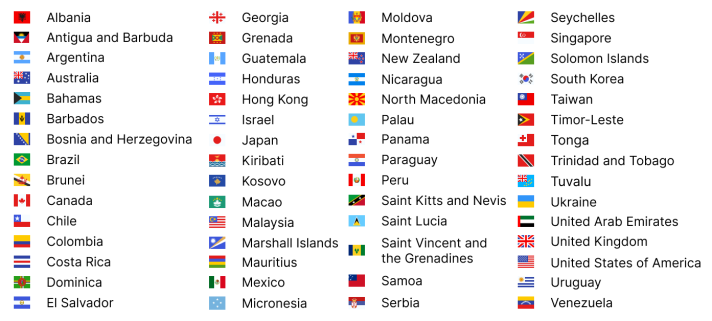
Visitors to Spain from any country that is not in the European Free Trade Agreement (EFTA) are subject to the 90/180 rule. Use our 90/180 rule calculator to help you stay within the rules.
The 90/180 rule means you cannot stay in the Schengen or ETIAS area for more than 90 days in any 180 day ‘rolling period’. (The ETIAS area is almost the same as the Schengen area, but not exactly. The ETIAS area isn’t operational til 2025. You can read more about this at the bottom of this page).
The idea of the ‘rolling period’ confuses some people. Basically, at any point that you are in the relevant countries, if you count back 180 days (6 months) from today, and see that you have been 91 days or more in the whole Schengen (or ETIAS) area over that time, you have overstayed.
Let’s take a couple of examples. In the same year, if you spend 30 days in the area in January, and another 30 days in April, you have used 60 days. If you then spend another 30 days in August, at the end of that time you will still be on 60 days. Why? Because at the end of August, counting back 180 days, you will find those 30 days from April, but you won’t find the 30 days from January, because they were more than 180 days ago. The 180 days is like a shadow you cast behind you, back in time, and in August, it has ‘rolled forward’, meaning January is no longer in the shadow, but April still is! Now, if you add yet another 30 day trip, and this next 30 day trip is in May of the following year, at the end of that trip you would have used 30 days. This is because you will be in a new rolling period. Why? Because when you count back 180 days from May of the following year, there will be no other trips included in that period that goes 180 days back from there.
If you are in the area or planning to visit the area and you have already visited in the last 6 months or so, you can put the dates of your recent trips into the calculator and then the dates of your current and next trips, to ensure you won’t go over your limit.
If you haven’t visited the area in the last 6 months but you are planning a long trip or several trips over the next 6 months, you can use the calculator to add all the future dates together to ensure they don’t exceed 90 days in a 180 day period.
With our 90/180 rule calculator, you can add as many entry and exit dates as you like. It will tell you whether you will be over your 90/180 day rule limit at any time.
Add entry and exit dates in the past, present or future in chronological order. The calculator takes into account the rolling 180 day period by counting backwards from your exit date for each trip, and adding together the number of days you have been (or will have been) in the area over the last 180 days, at the time of your exit. Your remaining days are then given. If, when you enter the area, you have not been in the area in the past 180 days, a new rolling period begins & your allowance is reset. This is the same way that official databases will asses whether you are remaining within the rules.
Whilst every effort is made to ensure accuracy, the calculator is for guidance only and does not constitute legal advice. No responsibility is assumed for use of this tool.
Passport holders from the following countries do not require tourist visas to visit Spain for up to 90 days for business or leisure. However, they will require an ETIAS authorisation from 2025:

Once you have your ETIAS authorisation, you will be able to visit the following countries for up to 90 days within any 180 period, for up to 3 years or until your passport expires:

Travellers holding passports from the following countries need tourist visas in order to visit Spain for business or leisure for up to 90 days:
Spain is in the Schengen Area. This means your tourist visa for Spain is actually a visa for the Schengen Area. It allows you to visit the entire area for up to 90 days in any 180 day period. There are different types of Schengen visa available. For example, your visa may be valid for 3 or 5 years, and it may allow you to enter and leave the area only once (single entry) or as many times as you like (multiple entry) during the validity period of the visa, so long as you do not stay for more than 90 days in any 180 day period.
1. Citizens with passports from European Free Trade Agreement (EFTA) countries can visit Spain for up to 90 days without the need for a visa or an ETIAS authorisation. These citizens are still subject to the 90/180 rule.
The 31 countries of the EFTA include:
4 non-EU countries:
Iceland, Liechtenstein, Norway and Switzerland
Plus the 27 countries of the European Union:
Austria, Belgium, Bulgaria, Croatia, Republic of Cyprus, Czech Republic, Denmark, Estonia, Finland, France, Germany, Greece, Hungary, Ireland, Italy, Latvia, Lithuania, Luxembourg, Malta, Netherlands, Poland, Portugal, Romania, Slovakia, Slovenia, Spain and Sweden.
2. Citizens from the following additional countries can visit Spain for up to 90 days without a visa (although you may be asked for proof of funds, accommodation, healthcare or return flight):
Albania
Andorra
Antigua & Barbuda
Argentina
Australia
Bahamas
Barbados
Bosnia and Herzegovina
Brazil
Brunei Darussalam
Canada
Chile
Colombia
Costa Rica
Dominica
East Timor
El Salvador
Georgia
Granada
Guatemala
Holy See
Honduras
Israel
Japan
Kiribati
Macedonia)
Malaysia
Marshall Islands
Mauritius
Mexico
Micronesia
Moldova
Monaco
Montenegro
Nauru
New Zealand
Nicaragua
Palau
Panama
Paraguay
Peru
S. Vincent and the Grenadines
Saint Christopher and Nevis
Saint Lucia
Samoa
San Marino
Serbia
Seychelles
Singapore
Solomon Islands
South Korea
Tonga
Trinidad and Tobago
Tuvalu
United Arab Emirates
United States
Uruguay
Vanuatu
Venezuela
Schengen Countries
As of 2024, the Schengen Area encompasses most EU countries, except for Cyprus and Ireland. It also includes the non-EU States Iceland, Norway, Switzerland and Liechtenstein.
Bulgaria and Romania will join the Schengen area for visits by air and sea as of 31 March 2024. Talks are ongoing to eliminate borders for land crossings.
25 of the 27 countries of the EU (all except Cyprus and Ireland):
Austria, Belgium, Bulgaria, Croatia, Czech Republic, Denmark, Estonia, Finland, France, Germany, Greece, Hungary, Italy, Latvia, Lithuania, Luxembourg, Malta, Netherlands, Poland, Portugal, Romania, Slovakia, Slovenia, Spain and Sweden.
Plus:
Iceland, Norway, Switzerland and Liechtenstein.
26 of the 27 EU countries (all except Ireland)
Austria. Belgium. Croatia. Czech Republic. Denmark. Estonia. Finland. France.
Germany. Greece. Hungary. Italy. Latvia. Lithuania. Luxembourg. Malta.
Netherlands. Poland. Portugal. Slovakia. Slovenia. Spain. Sweden
Plus:
Iceland, Norway, Switzerland and Liechtenstein
Share this page:
The information presented on this site is intended as a guide & does not constitute legal advice. No responsibility is assumed for any consequences resulting from use of the site. Prices, links, processes & other details presented can change from time to time. If you notice anything that needs updating, contact us. Reviews and ratings are subjective and do not necessarily represent the views of this website. Affiliate links are used in some areas of this site. This means if you use one of these external services, we may receive a small commission to support our running costs. We choose our links carefully based on what will be of interest to our readers. Affiliate links do not add any costs for our readers & in some cases they provide discounts.
© 2024 sitges for everyone All rights reserved